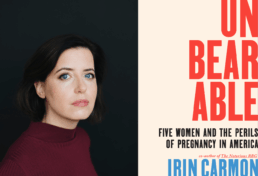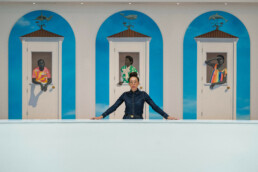Three Questions About...Embracing Your Crone Era
It’s a thing, says Nina Bargiel.
BY BRIJANA PROOKER
In the age of Ozempic and deep plane facelifts, in which every outward sign of aging is reversible as long as you have the luxury of money, author Nina Bargiel has a revolutionary idea: Embrace your crone era. It’s a spooky concept, particularly post-2020, when staring at our faces over Zoom prompted a plastic surgery boom, pushing us past body positivity and even body neutrality, all the way into mainstream body hate. But it’s Halloween, the perfect time to honor our wisdom and warts.
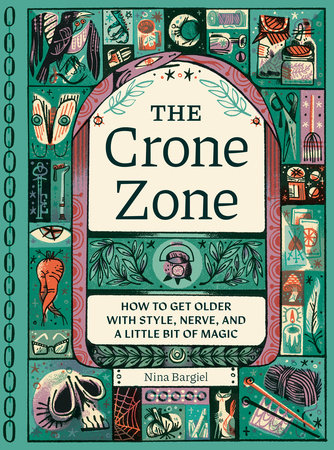
In THE CRONE ZONE: How To Get Older With Style, Nerve and a Little Bit of Magic, children’s TV writer Bargiel, 53 (who famously wrote the bra episode of Lizzie McGuire), uses the triple goddess concept to answer a key question: what's a crone (AKA any woman over 35, according to my Instagram feed) to do? “Fuck it,” Bargiel writes.
You’re a self-declared crone in your 50s. How would you describe “crone” for the modern era?
So Baba Yaga has always been my bitch. Baba Yaga is the [Slavic] crone who has self-selected herself into the woods. She lives in a hut atop chicken legs. She has a terrifying fence made of human bones. When a traveler gets lost and knocks on her door, sometimes Baba Yaga eats them. And my thought is, this woman has given every indication she does not want to be bothered. So if you’re knocking on her door, and she ends up frying up your liver, you kind of deserve it, because she has made it very clear: leave her alone.
For me, a crone is a woman who is sick and tired of making herself small to make other people feel comfortable. I refer to it as when your inner “fuck you” becomes your outer “fuck you.”
In your book, you say, “Whether gracious grandmother or wicked witch, the crone is always cast as a woman whose best days are behind her.” What are we getting wrong about how we understand crones?
The crone is overlooked and looked down upon, yet the crone is filled with magic. It’s funny because society [says] you're invisible and you're useless. But [crones also] have wisdom and power. If you think about Shakespeare and Macbeth and the three witches, I mean, they're terrifying. Like, they are hags, but they will mess you up. And I will say, [the definition of] “older women” keeps getting younger by the day. I was talking to a woman at one of my [book] signings…about my crone book, and she was like, “I need this because people are treating me this way.” She's 28 years old.
I love your crone touchstones: “Wisdom, to know who we are, Knowledge, to understand what we want, and Fuck It, to do what we please.” What does “Fuck It” mean to you?
[As a woman in a male-dominated writer’s room], you’ve got to be nice, you’ve got to get along. I played that [role] for a long time, and I discovered that it didn't get me any further. I would bite my tongue, and then these men wouldn't hire me again anyway. So why was I biting my tongue? I might as well just be 100% who I am.
When COVID hit, and I had a divorce, and the entertainment industry was taking a bad hit, I just got sick of pretending everything was fine all the time. I sold my house [in Los Angeles] and moved in with my parents [in Illinois] and got a job working in the cheese department at Whole Foods. And there are people who are like, “You shouldn't say that because people won't take you seriously as a writer.” If people don’t take me seriously as a writer, after 25 years, after two Emmy nominations, after two Kids’ Choice Awards and a Gracie Allen Award, they were never going to take me seriously. So my Fuck It is, if you look at me as lesser because I'm part of the labor force, then I feel sorry for you, because life's gonna hit you hard.
Another part of Fuck It is I am 53, and my boyfriend just turned 35, so he is 18 years younger than I am, and fuck it, I don't care. There are a lot of people that have said a lot of things, and by the way, they're mostly men. Almost every woman, when they find out, are like, “Oh, good for you, sister.” If someone's gonna try to shame me for that, fuck it.
Women cannot build a hut atop chicken legs or have a fence made of human bones [like Baba Yaga]. But we can wear headphones. We can have all of these things that say, “Do not bother me,” and yet the travelers, who are usually men, still come knocking at our doors. Unfortunately, we cannot fry up their livers, but we do not have to entertain whatever it is they have to say.

Brijana Prooker is a Los Angeles-based freelance journalist and essayist covering health, gender, and culture. She's a proud pit bull and cat mama whose work has appeared in ELLE, Washington Post, Good Housekeeping, and Newsday.
The Complex Landscape of Pregnancy in America
A new book dives into what the experience is like—and why
By Rebecca Carroll
If you’ve ever been pregnant (to term or not), you know that suddenly your choices are of public interest, and sometimes outright judgment. Pregnancy is a deeply personal experience that also inescapably involves power, vulnerability, politics, and a litany of unjust systems built for only certain beneficiaries. In her latest book, Unbearable: Five Women and the Perils of Pregnancy in America, journalist Irin Carmon weaves together narrative stories and reporting to create a lucid, sometimes heartbreaking, chronicle of how pregnant people are guided, or too often misguided, to navigate the experience in America.
Rebecca Carroll: I want to start by asking about something you wrote in the book’s introduction, which is that “being pregnant in America means bearing the consequences of separating one form of reproductive care, abortion, from everything else.” What is “everything else,” and what do you mean?
Irin Carmon: All other forms of reproductive medicine—prenatal care, birth, infertility, pregnancy loss—or even gynecological care in general. Before the white male takeover of medicine [in the mid-19th century], all reproductive care [including abortion] was more integrated into communal life, really across cultures. It was a group of women who were surrounding somebody at different stages of their reproductive life, from the onset of menarche through pregnancy and childbearing. I’m not saying that that system was perfect or that the old way was the right way, but I was really struck reading the history of the first abortion bans—as we live under the yoke of the new abortion bans, which are even more draconian and enforced with much more efficacy—that abortion bans and the white male medical establishment takeover of medicine were inextricably linked to each other.
It struck me as one of the many original sins of [modern] medical care. The other one being that the foundation of contemporary gynecology and obstetrics was American enslavement, and the unjust experimentation on enslaved women.
The part about experimenting on enslaved Black women was really hard to read—I actually physically winced. I think the narrative around childbearing and -rearing for Black women in America is so fraught, from the brutal, harrowing reality of how it all started with enslaved Black women, to the way that Toni Morrison used to talk about mothering as this gift of being able to keep and mother our children. How did you reconcile the different ways that Black women and white women experience pregnancy care?
Dr. Yashica Robinson [an Alabama-based OBGYN and former abortion care provider] was actually one of the starting points for me wanting to write this book. In so many ways, the work that she does is the embodiment of what could be a better way. I first met her in 2014 when I was reporting for MSNBC, and I had come to interview [her husband], who ran the only Black-owned clinic in Alabama. Dr. Robinson walked into the room, and when she started talking, I thought, “Who is this? Did I come to interview the wrong person?” I thought, this is the person who I want to learn from, and to help me understand the truly bifurcated, painful dichotomy you are talking about. Another Black woman I write about in the book, Christine Fields, died in the same hospital as Maggie Boyd, a white woman I also write about. They were both harmed by the same doctor. But…Maggie was able to come home and raise her son because when her husband screamed for help, he was listened to. And when Jose [Christine’s husband] screamed for help, they called security on him, and wouldn’t let him be in the room.
They left Christine alone, maybe because she was being treated like a problem, [and] we know from the research that Black women are much more likely to be treated in medical settings as a problem when they question the treatment or the care that they’re getting.
When I had an abortion in the 90s, even though I didn’t hesitate, I still felt so much shame, in no small part because of the picketers outside the clinic calling me a murderer. Where do you think shame falls today in the broader conversation?
The shame of being a “bad mother,” whatever that means to the person uttering it, is very powerful. And the anti-abortion movement has done a very effective job in making people—even when they’re feeling a sense of relief, which is the most commonly cited feeling around an abortion—feel shame for being a “bad mother.” I write about the work of Lynn Paltrow [founder and executive director of Pregnancy Justice] and Dorothy Roberts [civil rights scholar and author of Killing the Black Body] in the book, and I think they have so powerfully shown how this shaming of pregnant people’s very existence is so malleable that it can encompass somebody with a substance abuse problem, as well as somebody who drinks a glass of wine. Everybody thinks, “I won't be the person whose behavior is scrutinized.” [But] the post-Dobbs era has made clear just how broad the tentacles of policing pregnancy can be.
How has your own pregnancy experience been impacted by the stories and experiences you write about in the book?
I was postpartum when I read about Hali Burns getting arrested six days after her son was born; she was arrested in her son’s hospital room. And so I’m mindful of the fact that I’ve been incredibly lucky, but that I feel a sense of deep connection to these women [in the book]. The work of this book was in trying to go deeper to understand the factors in the systems that led us to any given situation, because I’ve been the recipient of some low-key shitty pregnancy care, and I’ve had some incredible pregnancy care. For people who choose to go down this path, everybody deserves to have access to what I had access to.
“I saw a photo and my heart just dropped”
|
Good evening, Meteor readers, I’ve just stepped off a plane from Vienna, so I’m jet-lagged and 40% pretzel. Tonight’s newsletter is even saltier, featuring upcoming election news, Malala Yousafzai’s new memoir, and a powerful conversation between The Meteor’s Rebecca Carroll and Deesha Dyer, who was the White House Social Secretary during the Obama administration and worked out of the now-demolished East Wing for much of her tenure. Let’s get to it. Mattie Kahn and The Meteor team  WHAT'S GOING ONThis week, President Trump took a literal wrecking ball to the East Wing of the White House and referred to its demolition as “the beautiful sound of construction.” But this was an historic space, with a legacy that meant something to a lot of people. (It has housed the office of every First Lady since Eleanor Roosevelt, for starters.) Several Democrats have pledged to investigate Trump’s “renovation,” and the public wants answers. In the meantime, though, those who worked in the East Wing are grieving—including former White House Social Secretary Deesha Dyer, who held that job during the last two years of the Obama administration. To get a sense of what this moment means, Rebecca Carroll called her.  DEESHA DYER WITH THE OBAMAS (COURTESY OF THE OBAMA WHITE HOUSE) Rebecca Carroll: It must feel so surreal to have been part of the first Black presidential administration in the White House, and to experience this demolition in real time—can you put that into words at all? Deesha Dyer: I can’t. It’s hard, Rebecca. I’ll be honest with you, because right now we’re having so many fights on so many other fronts. This morning I was helping a family get food and find housing. I avoided the photos [of the East Wing] and the conversations, because right now I need to focus on the basic needs of people. And then I saw a photo, and my heart just dropped. It affected me more than I thought it would. Because what we see, as one of my colleagues said, is a metaphor for everything happening right now. The destruction of the East Wing is a destruction for so much of what’s happening in our neighborhoods, in our communities. And as hard as it is going to be to ever rebuild the East Wing back, that is how hard it’s going to be to rebuild everything back. RC: Can you imagine a scenario in which President Obama would ever have been like, “I’m going to demolish…anything”? DD: No. He couldn’t even wear a tan suit. You know what I mean? I remember we had an event doing yoga in the East Room of the White House, and it was like, “Can we do that? Is it okay to lay yoga mats down on this historic floor?” Anything that we did, we did with extra scrutiny. I can’t even imagine if President Obama had cut down a bush outside of the White House. It would’ve been: “How dare you do this to America? You’re desecrating the country!” RC: You noted on Threads this week that three Black women have run events in the East Wing, including yourself, and you ran those events for the first Black First Lady. How symbolic does it feel that Trump chose the East Wing to demolish? DD: Very symbolic. That’s where the First Lady’s office has always been, and so it symbolizes what he thinks about women in general—and women in power specifically. The East Wing is also where people enter for tours and celebrations and all types of events. So it also says a lot about what he thinks about opening up the house, and making it really the people’s house. ... This is a property that is paid for by taxpayers. It is the people’s house. So it is not his. RC: And did you and the former First Lady ever have any conversations about the significance of the East Wing? DD: Definitely. All the time. Mrs. Obama talked to the entire staff about what her vision was for the East Wing and the White House. She always wanted to make it so it felt like everybody’s house. We made sure that from the minute you stepped in the door, you felt like this is a place that considered who you were, whether it was your culture, whether it was your family, whether it was anything. It’s jarring to see that all just gone. RC: What does that space mean to you personally? DD: I’m a Black girl from Philly—a hip-hop writer who had a community college education. I was also in charge of bringing to life the vision of Mrs. Obama and President Obama. And so for me, the space means possibility and hope. And we know that the history of the White House is not all grand. We know the implications of it being built by slaves. But we did our best to make sure that people saw themselves in it. That yes, our ancestors built the building, but we can dance in it. We can have joy in it. We can have our art in it. We can have our music in it, and be happy about that. RC: How are you taking care of you right now? DD: I’ll keep it a buck, I’m not. I’m constantly thinking, “This is terrible. This is a mess.” I’ll be on a walk with my husband and get a call about a food bank or a family in need. And so it's hard to take care of myself at this time. But I have to remember that I am a Black woman in this country that is a product of systems. I have type two diabetes and high cholesterol and high blood pressure. And so the system is also trying to kill us softly while it’s trying to kill us fast too. I need to continue going to therapy and taking my medicine and encouraging other people…. I’m not probably doing the best I could taking care of myself, but I’m trying.  THIS WEEK'S DEMOLITION OF THE WHITE HOUSE'S EAST WING (GETTY IMAGES) AND:
 FOLLOW THE METEOR Thank you for reading The Meteor! Got this from a friend?
|
![]()
A First Step Toward the Future
 October 14, 2025 Fair Monduesday, Meteor readers, It’s going to be a dark week in our nation, and not just because the fall weather is finally settling in. This week, a powerful, malevolent force is convening. We are, of course, referring to the Moms for Liberty Summit in Florida, which kicks off in two days.  In today’s newsletter, we consider what’s missing from peace negotiations (hint: it starts with a W). Plus, two former editors-in-chief take the shame out of being shitcanned.  WHAT'S GOING ONA first step toward the future: Last week, the world breathed a sigh of relief when Israel and Hamas accepted a ceasefire agreement that would see the release of both Israeli and Palestinian hostages and allow aid to enter Gaza. As expected, Donald Trump took much of the credit for the agreement. But after a weekend of families reuniting with their loved ones, news broke this morning that Israeli soldiers had already shot and killed at least nine Palestinians who were returning to their homes in Khan Younis. This is, unfortunately, a familiar situation—a ceasefire announcement, a brief moment of joy, a ceasefire violation, and then a renewed cycle of violence. But as more nations publicly demand an end to the genocide, there is a growing hope that this time will be different. And it must be different. Over the last two years, more than 67,000 Palestinians have been killed (although the UN believes this may be an undercount), and more than half of those killed were women and children. Yet despite the disproportionate impact the conflict has had on women and children, peace negotiations and planning for the future have been led almost entirely by men. This isn’t exactly a surprise considering the makeup of the governments involved, but it is, as history has shown us, a failing strategy. Earlier this month, the United Nations commemorated the 25th anniversary of Resolution 1325, which urged leaders to “increase the participation of women and incorporate gender perspectives in all United Nations peace and security efforts.” “Where women lead, peace follows,” Sima Bahous, the executive director of UN Women, said in a speech to the Security Council. (Data backs her up: Peace is 35% more likely to last 15 years or more when women are at the negotiating table.) In this moment, where over 600 million girls are living in zones of conflict worldwide, it seems like the right time to try a different approach. Click here to learn how you can support aid and rebuilding efforts in Gaza. AND:
 ALL THEY DO IS WIN. (VIA GETTY IMAGES)
 Three Questions About...Getting FiredNo shame in getting shitcanned, say Laura Brown and Kristina O'NeillBY CINDI LEIVE  TWO COOL FIRED GALS (COURTESY OF GALLERY BOOKS) Getting unceremoniously sacked has always been an occupational hazard for magazine editors; back in the 1980s, Vogue’s Grace Mirabella reportedly found out she’d been let go when she heard it on the TV show Live at Five. But when it happened to Laura Brown (the former head of InStyle) and Kristina O’Neill (of WSJ Magazine), they eventually realized that, to quote Nora Ephron, everything is copy. These two friends (and, full disclosure, friends of mine) sat down to write a book about the experience: All the Cool Girls Get Fired, in which everyone from Oprah to Carol Burnett tell their own pink-slip stories. It couldn’t be better timed. Earlier this fall I ran into an acquaintance on the subway and was telling her about the book. We noticed a woman next to us leaning close. “I”m sorry,” she said, “would you mind saying the name of that book again? I need it.” In case you do too, here are three questions for the authors. My first question is, the book is All the Cool Girls—not all the cool boys—Get Fired. So I'm curious—how is the experience of getting fired for women different than it is for men? Obviously it happens to them too. Kristina O’Neill: We noticed that there was a universality around the shame and the embarrassment and the disappointment that women respond to this sort of life event with. We noticed that a lot of men, if it has happened to them, it almost becomes part of their armor and part of their narrative—I mean, Steve Jobs, Mike Bloomberg, they made getting fired part of their entire work journey. Whereas when we sat down to write this book, we couldn't easily identify women who, after having been fired, owned it. It does seem like women have a harder time just saying what happened to them and moving on psychologically. Laura Brown: I asked [human resources pro] Bucky Keady: Why does it hit so much harder [for women]? And in one second she said, “Because it took so much longer to get there. It took us so much longer to get into that room.” So many of us feel shame and wallow. But it’s futile. And you have a community, but you're not going to find the community unless you put your hand up: Actually, me too. That happened to me as well. And then, God, that's a help. That's such a relief. But you have to speak up. Whose story of being fired surprised you, or made you see their career differently? KO: We were really struck by how many women hadn't talked about it before. Katie Couric, for example, kept saying, Well, they didn't renew my contract, and it was almost like a revelation in the conversation when I think it sort of dawned on her, like, Yeah, I guess I was getting fired! We [also] talked to a sports agent, Lindsay Colas, who’s brilliant and who literally got Brittney Griner out of prison in Russia, and another client called her after she got Brittney out of jail and said [something to the effect of], “You haven't been paying enough attention to us, we're going to go with a different agency!” So fired looks different for everybody: the language around it, the experience, the aftermath. But the universal thing is you feel like shit. LB: One of my favorite stories was from Tarana Burke; she was running an organization in Philly and she was comfortable there. Then she got fired. And in all this time, me too was sort of lying dormant in her head. So when she was fired, she was then allowed to open her mind to proceed with that. She said, I kept thinking, You've been carrying other people's visions to fruition for too long. And she was able to carry her own. How much did you know about Oprah’s firing [from her job as co-anchor of the Baltimore evening news] before interviewing her? LB: We knew the story a little, but again—it wasn’t the [big narrative] about her. She should be on the fired Mt. Rushmore with Steve Jobs and Mike Bloomberg and everyone else! When we talked to her, her memory of the firing was like muscle memory. It was so visceral. [“I really have never talked about it,” says Oprah in the book.] She remembered what the managing director of the TV network was drinking. She remembered it was April Fools’ day, and she thought it was an April Fools’ joke. Bang, bang, bang, bang, bang, she remembered all these things because sadly—it's almost like with Instagram comments when you remember the negative one and you forget all the nice ones. And Oprah got upset about it anew, but she was us. She was ashamed to tell her dad, she was ashamed she lost her job. But her story reminds you that [getting fired] fires up your dreams too. KO: If it hadn't happened to her, she would've never been in the prime position to be put up for that talk show. LB: Oprah told us, The setback is a setup. It's so tidy, but it's absolutely true: That thing that knocks you down can spring you back.  FOLLOW THE METEOR Thank you for reading The Meteor! Got this from a friend?
|
![]()
The Year of "Mar-a-Lago Face"
It’s time to talk about the campy aesthetic of Trumpworld women.
By Nona Willis Aronowitz
What, exactly, is the “MAGA look”? Like pornography, you know it when you see it: It’s an exaggerated performance of traditional gender norms so common among the women of Trumpworld that it’s known as “Mar-a-Lago face.” It may involve Botox, cheek implants, fake eyelashes, injected lips, glossy waves, and a surfeit of bronzer. Think of the over-the-top looks sported by DHS Secretary Kristi Noem, strategist Kimberly Guilfoyle, and former RNC chair Lara Trump (as well as a few rightwing men, like Florida congressman Matt Gaetz).
What does this increasingly ubiquitous look tell the world about gender and power? What do these women gain from transforming themselves? And is it even worth talking about, given the recent onslaught of horrors? I called writer Inae Oh–who consulted historians, sociologists, and plastic surgeons for the best piece I’ve read on the subject, a Mother Jones feature–to ask about the deeper meaning of the trend.
Nona Willis Aronowitz: Before we get into it, what would you say to those who think focusing on people's (and mostly women's) looks is besides the point—that we should solely focus on their terrible actions? Are we just using the same weapons against them that people have always used against women?
Inae Oh: I would say, “I hear you!” But I would also argue that it is a mistake to dismiss the issue as superficial–the aesthetics of fascism have long been preoccupied with restoring gender norms and ideas of perceived "perfection," something we clearly see playing out both in the aesthetics and politics of MAGA.
Believing that this is besides the point also risks misunderstanding the forces that animate Donald Trump: appearance over substance, one's TV performance over policy, propaganda vs. reality. These are some of the most powerful people in the United States, imposing some of the most consequential policies in decades. Their deliberate choices are worthy of interrogation.
Kristi Noem has been such a central figure in the last couple of months. What does her visual presence signal to you?
Her aesthetic choices dovetail very nicely with the administration’s promise to take mass deportations to an unprecedented level. This is a priority for them, and the face of that priority really matters to Trump. I think there’s a reason why it’s not Stephen Miller out there. Trump has explicitly stated to Noem, “I want your face in the ads.” She’s gone through a dramatic transformation from when she was South Dakota's governor to what she looks like now.
Basically, she’s a woman with a look that’s very rooted in conservative, traditional ideas of what a woman should look like: long, flowing hair, heavy makeup, form-fitting dresses–but at the same time she has that baseball cap on and she’s employing incredibly harsh and cruel and aggressive policy. That supposed contradiction is intentional. Her look also provides cover for the brutal policies that are being implemented across the country. [After Sen. Alex Padilla was forcibly removed from a press conference], Rep. Anna Paulina Luna (R-Fla.) defended Noem and described her as “the most delicate, beautiful, tiny woman.” She said, “What actual testosterone dude goes in and tries to break Kristi Noem?” All of a sudden, she’s a defenseless woman.
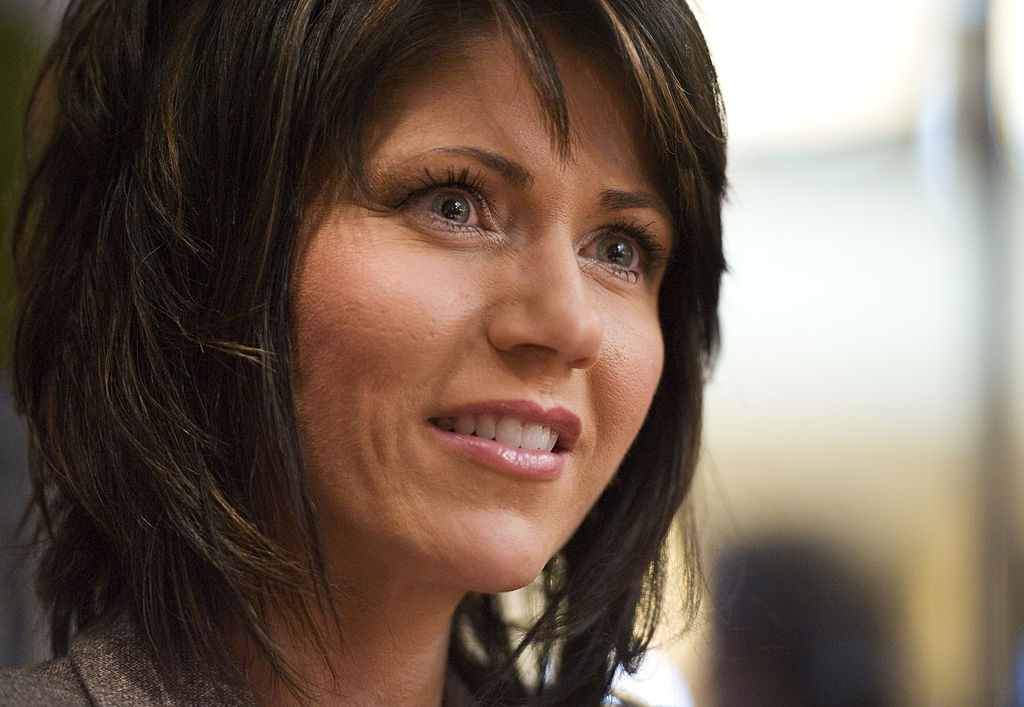
There are certainly some precedents to the MAGA look in conservative politics and media; Fox News hosts of the last couple of decades come to mind. What’s different now?
I mean, it’s Donald Trump. It’s turbo-charged now. This is a man who literally has a background in reality TV. This is a man who doesn’t really know policy, who only cares about how you appear and how you can sell a certain idea. And [Trump’s taste is] extremely garish. Trump is notorious for his love of gold. It can seem so tacky to me, personally, but to him, it signifies wealth and power. When you have the most powerful man in the world having those priorities, people use these visual signifiers to gain power and favor.
Is this really just a rightwing thing? Lots of people, particularly women, feel pressure to conform to a certain look, which increasingly includes cosmetic enhancements.
I’m also a woman in this world, and I absolutely partake in our capitalist beauty standards. Plenty of people on the left, people who are my friends, are also opting to undergo procedures like Botox. You have Gen Z on TikTok being very open about the work they’ve done on their faces. For the longest time, plastic surgery was not accessible to the masses…As it has gotten cheaper and more normalized, people have become more open about it, like how Kris Jenner documented her facelift.
So it’s not completely divided by politics, but I think what’s happening on the right is a bit different. It’s such an appeal to tradition, whereas on the left, there’s more of an embrace, politically and culturally, of gender fluidity. And there’s more of an embrace of sustainability with companies like Reformation and green-friendly makeup, whereas on the right, that’s not at all a concern; it’s all about excess.
Men are secondary to this phenomenon, but they’re certainly in the mix. How do you think the MAGA aesthetic plays out when it comes to masculinity?
Pete Hegseth, to me, is the male equivalent of Kristi Noem. Men like him wear these bright-colored blue suits that don’t just fade into the background, and are supposed to be a sign of patriotism. Their shoulders are extremely broad, whether that is natural or not. Their chins, their jaws are very chiseled. It’s such an aggressive, cartoonish way to represent gender norms, and that absolutely plays into this Donald Trumpian idea of a powerful man. It’s not as ridiculous as the women, maybe because they don’t wear as much makeup. Do these rightwing men want to be known for caring about their looks? Absolutely not. They would see that as a sign of weakness. But there have been reports of Hegseth installing a makeup room in the Pentagon. [“Totally fake story,” Hegseth responded on X.] He puts that same importance on visuals and the message, rather than budgets and policies.
The Evolution of the Rightwing Lewk
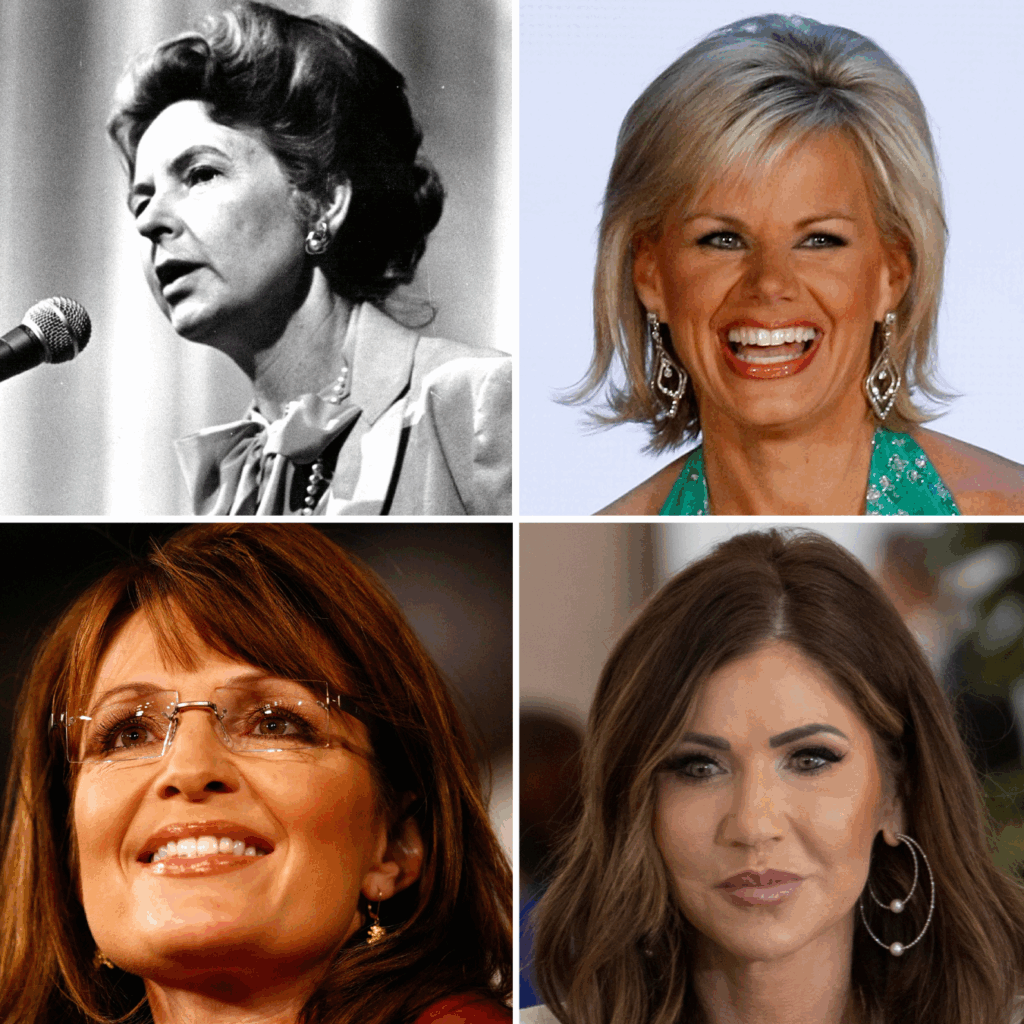
Conservative politics has always demanded that women perfectly embody the gender norms of the era.
1970s: Phyllis Schlafly
The “godmother of the conservative movement” intentionally wore ultra-feminine outfits–preppy pastels, skirts in the pantsuit era, and pussy bows–while attacking the Equal Rights Amendment.
Early ‘00s: Gretchen Carlson
Famously crowned Miss America in 1989, she was one of many prominent “Fox blondes.” (In a twist, she was later key to taking down Fox News CEO Roger Ailes for sexual harassment.)
2008: Sarah Palin
Known for her sexy soccer mom look (with a rifle!), she ushered in a departure from the gender-neutral appearance of most female politicians at the time.
2025: Kristi Noem
Tasked with carrying out some of Trump’s cruelest policies, she is the platonic ideal of Mar-a-Lago face: pillowy lips, blinding white teeth, long wavy hair, and lots of makeup.
The Wonder of Amy Sherald
Ordinary Black life is extraordinary in the artist’s first major mid-career museum survey.
By Rebecca Carroll
Last month, The New Yorker featured a breathtaking portrait on its cover by celebrated Black American artist Amy Sherald. First painted in 2014 and titled “Miss Everything (Unsuppressed Deliverance),” the portrait of a young Black woman wearing a bright red hat is the same piece Sherald later submitted in a competition at the National Portrait Gallery. She won the competition, which caught the attention of former First Lady Michelle Obama, who then personally chose Sherald to paint her portrait for the National Portrait Gallery—making the Georgia native the first Black woman artist to be selected for an official presidential portrait. The Obama painting changed the entire trajectory of Sherald’s career, and since then her figurative grayscale portraits have been shown in public and private collections around the world.
Now, Sherald is having her first major museum survey at The Whitney Museum of American Art, called American Sublime, a title borrowed from the poet Elizabeth Alexander’s book of the same name. I’ve known and admired Sherald for years, and I was thrilled to sit down with her to talk about her work in this truly transcendent exhibition.

Rebecca Carroll: The last time we saw each other in person was pre-Michelle Obama portrait, when we randomly ran into each other on the street in Brooklyn. And here we are today to discuss your first solo exhibition at The Whitney. How are you feeling?
Amy Sherald: I told a friend last week, “I don’t know, I just feel emotional.” And she’s like, “Well, you’re getting used to belonging to the world, and not just to yourself.” Hearing that made me want to cry, and I left her a voice text, and said, “Okay, I’m sitting here holding back tears because I am a thug and I do not like to cry. But that’s exactly what I feel like.”
It’s a lot! The show is also set against a backdrop of political turmoil in America, particularly in regards to race, and actually not dissimilar to what we were experiencing when we last saw each other. At that time, the height of Black Lives Matter, I had written a piece for the LA Times, saying “Even as we see images of what most of us already know, that police violence against Black people in America is occurring with vicious regularity, something remarkable is materializing in its wake. We are also bearing witness to a pronounced moment of Black cultural ascension.” How has your work been impacted by eras of Black cultural ascension versus centuries of Black oppression?
My work was essentially born out of the desire to free myself from a history of oppression, but also in celebration of these eras of enlightenment. What I want the viewer to experience, and I say this in the exhibition [statement], is “the wonder of what it is to be a Black person.” I’m no longer religious, but I speak about this in that language of flesh and spirit—because part of us always has to be activated [in fighting oppression].
Right, exactly. I know you consider yourself as much a storyteller as an artist. As Black storytellers, I feel like we never make anything without parts of each other within us—intergenerationally, ancestrally, futuristically. But when the work goes out into the world and starts to belong to non-Black people, I sometimes feel these waves of protectiveness about it. Do you ever feel that way about your work?
I want the work to belong in the world because it was the only way that I could figure out how to counter whiteness, and the way that everything is saturated with it, comes from it, and evolves around it. My response to that is to make something that’s just as universal, and that can be consumed in the same way, because then [white people] are going to be consuming it in the same way that I had to consume Barbie, and all of these other things.
A pointed example for me was when your portrait of Breonna Taylor was on the cover of Vanity Fair, and it felt so unjust to me that suddenly white people were allowed to look at her in this way that we had seen her all along. Did you feel any conflict about that specific piece?
I didn’t, because of how it started. It started with Ta-Nehisi [Coates], and I trusted him and his vision. Maybe if the call had come from somebody else, then yes, but because it was Ta-Nehisi, no.
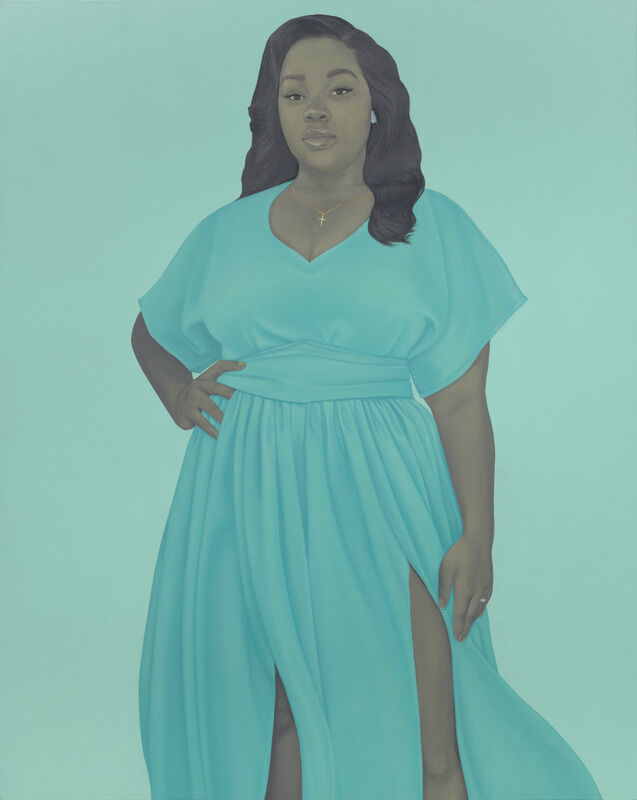
To clarify for our readers, Coates was the guest editor for that particular issue of Vanity Fair, and so that makes a difference, for sure. Now that the portrait is part of this exhibition at The Whitney, what has been the broader response to it?
A lot of people, of all races, are moved to tears by it. After I first finished it, I was really just thinking about how I’ve made this portrait, we’ve photographed it, it’s been on the cover of Vanity Fair, and now it’s in my studio. Now what can it do? I started some conversations, and it ended up being acquired by the National Museum of African American History and Culture. And now there’s a Breonna Taylor Legacy Fellowship and Breonna Taylor Legacy Scholarships for undergraduate students and law school students [at the University of Louisville, in Louisville, Kentucky, where Taylor lived; the fellowships are funded by proceeds from the portrait’s sale]. So if a student is doing anything in regards to social justice, whether their major is political science or art, they have an opportunity to get this scholarship. And then if a student is in law school and wants to work expungement [when a criminal record is erased or made unavailable for public access] cases in Alabama, which pays nothing, then here’s $12,000 to get you through your summer.
Does the idea that Black artists do work for each other resonate with you?
I feel like we make what we make because we are who we are. My mom told me this story about myself, and it stuck with me because I think my work sits in the world in the same way. [When I was a child] sometimes when we had dinner, I would just randomly get up and walk around the table and touch everybody on their shoulder and say, “I love you.” I would go all the way around, and then come sit down and finish my dinner. I think these portraits are “I love yous” out in the world to affirm anybody who is willing to see past the exterior and go deeper into their experience of what it means to be a human.
I love that story. And what do you experience when you look at your work?
I feel like the work sits in The Whitney, and there are words on the wall that explain it, but that work is me—somebody who was once a people pleaser and had a problem saying no, someone who doesn't like conflict or confrontation. My personality made that work.
I would never have looked at your work and thought, “These pieces were made by someone who had a problem saying no.” Are there specific things in the pieces that signal that to you?
I guess that’s where the beauty comes from, because the work doesn’t yell at you. It speaks to you nicely. If you feel uncomfortable in the presence of a Black person, this work will make you think, “Okay, well, maybe I don’t need to grab my purse. I might feel safe in the elevator with this guy.” It speaks to people that way. I went to Catholic school from K through 12, and was always one of two or three Black kids, so I have a lot of patience. I learned a lot of, “Let me explain to you why you can't say that.” Versus my friends that went to all-Black high schools, where it’s just like [gestures taking her earrings off], “Let me tell you…”
But you feel differently now, right? You’re in a different place. How do you think that will affect your work moving forward?
I’m not sure how the work is going to evolve to match who I am now, which is somebody who’s stronger, who doesn't mind saying no, and will look at you while you feel uncomfortable with my answer. I am excited because everything that I’ve made in this show has been living in my head for 20 years.
Does it feel like a kind of excavation in that way?
It feels more like a birth than an excavation. When I think about Black American art history and just our legacy within the larger canon, I feel like we don’t or can’t function on the same timeline as everybody else. It still feels like the beginning of something, this moment of myself, Rashid Johnson, Lorna Simpson, and Jack Whitten [all currently having museum shows]. It feels really great despite everything that’s happening. The art world is representing the world that we want to be—the real world right now.
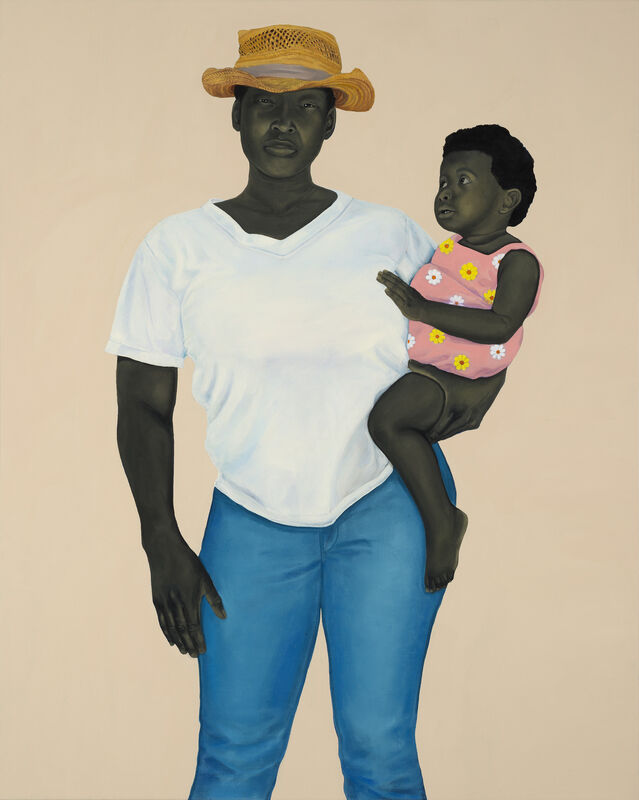
What happens next for you?
I’m hoping that this show will make it into the National Portrait Gallery without having to make any compromises based on who’s sitting in an office at the White House. And I don’t mean, “Well, if I can’t have this painting of two men kissing and a trans person, then I’m not going to do the show.” I feel like that would be a mistake. I feel like it’s a mistake to step down from boards just because [Trump] wants to take over the Kennedy Center. Now more than ever, I feel like it’s important we be in those rooms and not shutting down the conversation. I think the bigger moment would be the work being in the Smithsonian Institution and people coming there to look at American history and Presidents, and then walking into my exhibition.
Whatever the fate of the work in this show, one of the things that really came through as I was walking through the exhibit, just like the way you used to walk around your family’s dinner table and tell everybody you love them—all of these people are taking care of each other, and I felt tapped on the shoulder and loved by every one of them.
Exactly as you should have felt.

